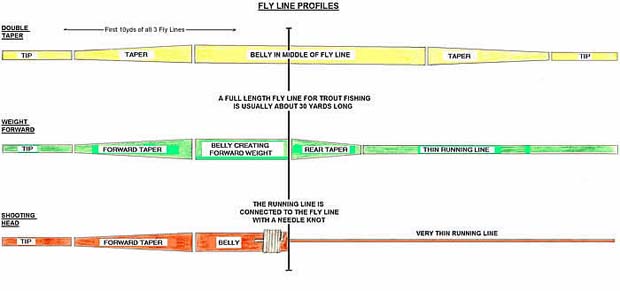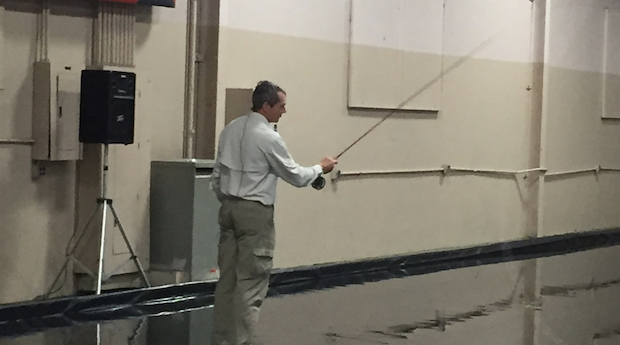Weight Forward. Hallelujah?
[dropcap]M[/dropcap]any of us with gray or balding pates were initiated into the fly fishing fraternity using double tapered (DT) fly lines. Shortly after initiation, weight forward (WF) fly lines took stage and became the wildly popular “more distance.” It was the club to belong to. The exodus away from DT was a stampede and today, weight forward remains the go-to fly line profile.
Today there are variations on WF tapers: diameters, densities and other variables like head, and running line – making selecting a fly line difficult. For example, use the wrong rod, add the wrong line and compound that with the wrong leader and you are probably looking at a scoreless day. But a little patience and researching will put you on some pretty impressive fish.
Fly shops
Combing the Atlanta fly shop guru’s, calling accomplished angling friends with many miles under their collective belts in both the salt and fresh water venues did not provide an answer to: Which is better, double taper or weight forward?
Forums and wrong turns
Forums have lots of opines on a myriad of subjects. When querying my question online (WF vs DT) via “forums,” I got laughable results from many narcissistic know-nothings – as are known to inhabit the internet world.
From the horses mouth
Bruce Richards, former product engineer for 3M Scientific Anglers, one of the days most knowledgeable fly anglers, casting instructors and fly line designers takes on the wildly misunderstood question, and performance capabilities of double taper (DT) and those of weight forward (WF) fly lines, as well as how modifications alter each tapers’ performance. Richards has designed fly line tapers for Scientific Anglers for more than 20 years. There are not many in the fly fishing industry who possess Richard’s knowledge on fly lines – and he shares the following on the DT vs. WF question.
Question? Which is the better taper – double taper (DT) or weight forward (WF)?
Bruce Richards’ answer: “Neither is inherently better, but one may be better than the other for you.”
“A lot of generalizations are made about these two tapers based on outdated or incorrect information. All fly anglers have heard that double taper lines are more delicate, give better control, roll cast better, etc. In some cases, these performance features of double taper fly lines are true, but not always.
Delicacy of delivery is determined by the mass of the front part of a fly line. This is determined by line diameter (which relates directly to mass), and taper length. A line with a small diameter tip and a long taper has much less mass up front than a line with a large tip and short taper. Don’t be mislead by taper length alone — a line with a long front taper but a large tip diameter will not deliver delicately. A DT and a WF line with the same taper and tip diameter will deliver the same.
 For many years, most DT and WF lines were made with the same tip diameter and front taper length so there was no difference in how they delivered, although many claimed there was. Today, many of the DT lines are actually designed specifically for use in spring creek-type fishing and do have longer tapers and/or smaller tips.
For many years, most DT and WF lines were made with the same tip diameter and front taper length so there was no difference in how they delivered, although many claimed there was. Today, many of the DT lines are actually designed specifically for use in spring creek-type fishing and do have longer tapers and/or smaller tips.
Anytime a fly line (or any product for that matter) is designed to do one thing very well it usually has a shortcoming somewhere else. Lines that are designed to be very delicate have little mass in the front to carry larger or heavier flies, and will not handle windy conditions well. It takes a better caster to throw the kind of loops it takes to make these lines perform their best. And no, DT lines are not a more ‘”accurate”‘ casting line — that is entirely in the realm of the skill of the caster.
It is very true that DT lines are easier to control and roll cast at long distances than WF lines. At shorter distances, there is no difference. The key to line control and roll casting is to make sure the large diameter line belly is in the rod tip. If the small diameter running line is in the tip, it’s nearly impossible to transmit enough energy through it to the belly to make the line do what you want. What many fly anglers don’t consider is that WF lines control and roll cast as well as DT lines at the distances most of us fish.
Almost all WF lines have heads that are 35-40 feet long. Add a 9-foot leader and the distance to the fly from the end of the head is 44- to 49-feet. Up to this distance when both DT and WF lines control and roll cast the same. There are not many typical trout fishing situations that require longer casts. What this all means is that DT and WF lines work pretty much the same at the distances we fish most often. Certainly if someone fishes a big river that requires a good deal of long distance roll casting and mending, a DT or a WF line with a long head should be considered. Either a Mastery Series XPS or GPX double taper or Mastery Series XXD weight forward taper would work well.
Everybody knows that WF lines are better for distance than DT lines, but is that really true? Well, yes, but the difference isn’t as big as you might think. Because of their small, light running lines, WF lines shoot better. But remember, this benefit starts at 44- to 49-feet when the running line is in the rod. If your fishing situation calls for many long casts, it is certainly a little easier to do with a WF line – but don’t think that DT lines won’t shoot. They will, just not as far.
For most fly anglers in normal fly-fishing situations, it probably doesn’t make a lot of difference which taper you use. Most of us fish at distances less than 50 feet, which is where weight forward lines start to shoot better, but with less line control. Most of us don’t have the need, or the ability, to roll cast longer than 45 feet.
So, how do you decide which is the right taper for you? Double taper or weight forward? For short to medium casting range situations, there is no reason not to have a DT line rigged and ready. If you are consistently throwing longer casts, you can make them with fewer false casts with a WF line. But if the need arises, you lose the ability to do long roll casts and mends. For most, it doesn’t make much difference which taper is used most of the time. Base your decision on DT versus WF on how much small fly, short distance fishing you do – when a delicate DT line like a Mastery Series XPS would offer advantages, against how much fishing you do where longer casts are needed – and the advantages of a WF line.”
This archived story (from our files) was probably originally sourced via John Mazurkiewicz (Catalyst Marketing, South Bend, IN), fishing industry field rep.


